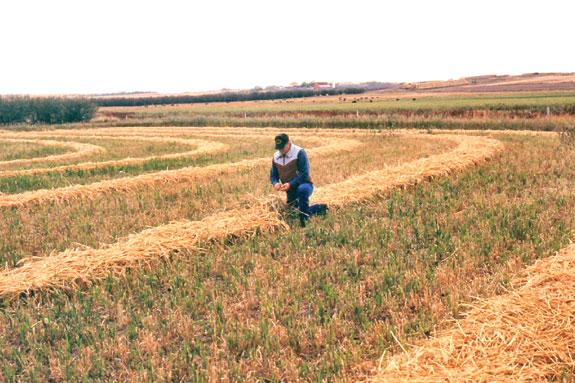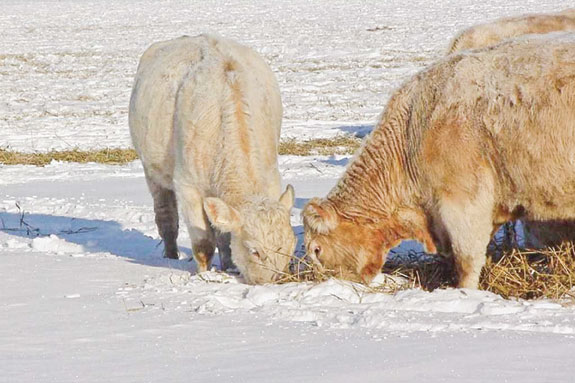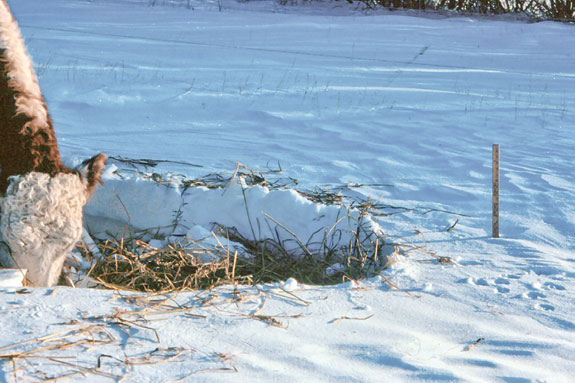Tim DelCurto of Eastern Oregon Agriculture Center at Oregon State University says their range livestock research stations have studied use of stockpiled forages, windrow grazing and rake-bunched hay.

Stockpiling
DelCurto says stockpiling works well if there is available water or snow for water.
Grazing dormant forage has minimal impact on plant health, compared to spring and summer grazing.
Winter grazing is best with dry cows (whose nutritional requirements are lower) because they can go greater distances to water and accomplish better use of slopes.
“We grazed some pastures into early summer, then took cattle off and stockpiled regrowth for late fall grazing.
We wintered cattle by providing supplemental protein on these pastures, reducing costs to about $30 to $40 per cow.” This works well if forage doesn’t snow under too deeply.
“The first three years, we wintered cows cheaply, with just 5 pounds of alfalfa per head per day. But the next year we had a severe winter and it didn’t work as well.
When you start cutting costs you also increase risk, and one of the biggest risks is Mother Nature,”
he says.

Windrow grazing
University of Nebraska studies found windrow grazing enables cows to efficiently utilize fall and winter pastures.
Jerry Volesky, range and forage specialist at University of Nebraska’s West Central Research and Extension Center, cites his research study using a meadow that had been grazed lightly and allowed to regrow.
“In early September we cut the forage and put it in windrows. In our experiment we compared leaving it in windrows versus baling, hauling it to a stockyard and then hauling it back to feed cows in winter.”
Grazing weaned calves on windrows from November through February, Volesky found the forage quality was equal to hay harvested in big round bales.
“Calf weight gain on windrow grazing was equal to that of calves fed traditionally on hay, and windrow grazing was cheaper,” he explains.
Grazing windrows requires labor to move electric fences but, in most situations, this is cost-effective.
“Another advantage is that you’re leaving nutrients in the field rather than hauling them off,” he explains. The remaining organic matter and manure improves fertility for the next few years.
Fields were strip-grazed in sections and calves had about a week’s time with nearby electric fences. “The calves wasted about 25 percent of the forage but we didn’t try to push them to clean up the feed,” Volesky says.
“After the study ended in February, we brought in dry cows. After the second go-round, our waste was probably equivalent to what you’d have feeding big round bales out on the field.”
Cut forages keeps better in large windrows unless wind scatters them. Moisture damage is a factor, but usually minimal unless there’s a lot of rain.
It helps to cut at higher stubble height than when cutting hay, so windrows are not lying directly on the ground.
“Feed lies in the windrow several months and there’s potential for mold, but once it’s cured and dry in the windrow, it doesn’t spoil much – other than discoloring the top surface from rain or snow through fall.
Underneath, we didn’t have any mold. This will depend partly on the amount of rain in the fall,” he says.
By leaving feed in windrows rather than letting cattle harvest it on the stem, you can cut it at optimum stage of maturity, locking in nutrients at a higher-quality stage. If left on the stem, it becomes overly mature and dry.

Rake-bunched hay
“The difference between rake-bunching and windrow grazing is that rake-bunched piles work better where there’s more snow,” says DelCurto. “It can be difficult for cows to find windrows when snow is deep.”
DelCurto uses an old bunch-rake to place hay in piles.
“We did years of research on this method and compared it to traditional haying,” says DelCurto. “The cost of winter feeding rake-bunched hay was $30 to $40 less per head. It’s very similar to windrow grazing.”
Rake-bunching and windrow grazing works well in some regions and not others. The Burns research station for Oregon State is at 4,000 feet with drier and colder temperatures.
The Union station, meanwhile, gets about 15 inches of annual precipitation and is 5 to 10 degrees warmer in winter but with more wind.
“For our location we found rake-bunching doesn’t work because wind may blow the bunches away,” DelCurto explained.
“With bunch-raked hay or with windrows, because it’s a little warmer and wetter, we’ve had more problems with hay not keeping as well. So we’ve focused more on winter-grazing stockpiled pastures, taking advantage of wind to blow the snow away.”
Annual crop
Glenn Shewmaker, an extension forage specialist at the University of Idaho, says there are many opportunities to produce more forage for grazing, especially when rotating a field out of alfalfa.
“You can take a first cutting, kill the stand with herbicide and plant an annual that will grow enough to graze or cut for windrow grazing,” he explains.
“With annual crops, you need at least 60 to 70 days of growing season to produce enough mass to more than offset planting cost,” says Shewmaker.
“After about 80 days, however, nutrient quality starts to decline as it becomes too mature. Depending on elevation and growing season, spring cereal crops do better than winter cereals if you’re planting by July 1. This gives July, August and part of September for the crop to grow.”
Other suggestions from Shewmaker:
- Oats are likely to produce the most and best-quality cereal grains, and a hay-type barley also processes well and appeals to cattle. He recommends swath-grazing to capture nutrient quality at the right stage.
- Corn is also worth grazing. Compared to regular corn, grazing corn is mostly earless or has small ears, and starch is distributed through the entire plant, making it all appealing to cows.
- Overeating on ears can lead to acidosis and foundering due to high starch content.
- With sorghum and sudangrass, don’t graze until it’s 2 feet high. Leave stubble height of 8 inches and don’t graze during or several days after a frost, due to prussic acid. “Cutting and drying, or using it for silage, will reduce prussic acid levels,” he explains.
- Canolas, grazing turnips and regular turnips produce high-quality feed, and don’t require harvesting since cows learn to seek them out. It’s important to strip-graze these crops, to limit intake and force animals to clean up each area.
- Turnips are good feed, since cattle will eat tops and root and they can be planted twice. One risk is that cows may overeat and struggle to swallow them whole.
Some producers mix several types of plants for fall grazing. Using different crops – sometimes in mixes or strips side-by-side – provides flexibility for grazing.
“On different years, some crops do better than others. When planting in mid-summer you don’t always know how long the growing season will be. It’s good insurance to have some cool-season cereals along with warm-season crops.” ![]()
PHOTOS
PHOTO 1: Rake-bunched hay is more visible to cattle in areas with heavy snow. Photo courtesy of Tim DelCurto.
PHOTO 2: Studies show windrow grazed pastures have forage quality equal to hay from big round bales. Photo courtesy of Tim DelCurto.
PHOTO 3: Swath/windrow grazing works even when fields are covered with snow. Photo courtesy of Lorne Klein.
PHOTO 4: If cattle know where the windrows are, they will root down through many inches of snow to find the feed. Photo courtesy of Lorne Klein.
Complementary forages
“In our area crested wheat seedings are beneficial on rangeland. They green up quicker than native grasses – allowing earlier spring grazing – and also respond to fall precipitation, producing high-quality late fall grazing,” says University of Idaho’s Glenn Shewmaker.
Some ranchers go out early on private range pastures to get cattle off hay meadows quicker. Crested wheat can fill this niche.
“We’re also working with forage koshia and other complementary forages that work well for winter grazing because they’re high in protein,” he explains.
Anything that extends the grazing period – spring or fall – can help reduce costs. “Some ranchers in our area feed hay until May.
If they go out on pasture or range earlier, they pay the price later because this doesn’t allow forage to get a good start.
The old saying that ‘range readiness is when the grass is taller than your haystack’ is all too true. It might be that way again next spring, with the price of hay.”







